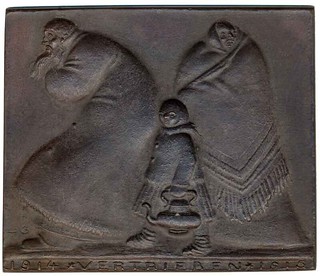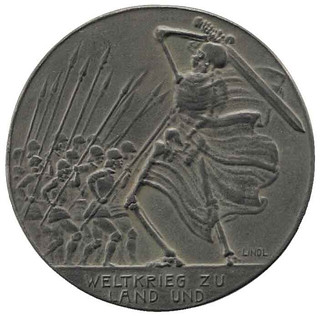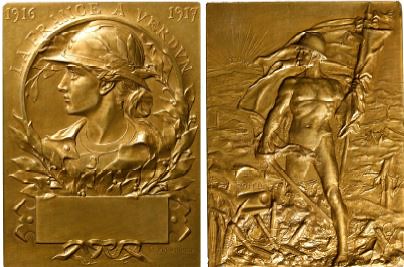
PREV ARTICLE
NEXT ARTICLE
FULL ISSUE
PREV FULL ISSUE
NUMISMATIC EXHIBITS ON WORLD WAR I CENTENARY
This article, also in the April 2013 issue of Money & Medals, is an interview with the curators of two new
numismatic exhibitions on World War I.
-Editor
An interview with the curators of two new WWI numismatic exhibitions Shailendra Bhandare, Assistant Keeper, Heberden Coin Room, Ashmolean Museum and Tom Hockenhull, Curator of Modern Money, British Museum Can you give a broad overview of your exhibition and how it fits (or doesn't) into how your museum is approaching WWI? TH. As part of the centenary commemorations for the outbreak of the First World War, the British Museum is examining the German experience through a display of medals made by artists who lived and worked in Germany during the war. Emerging art movements such as expressionism were adapted to the form of the medal, whilst artists also looked to Germany’s past, blending medieval and Renaissance styles. Expressive and sometimes provocative, they document the realities of the conflict from both an historical and an emotional perspective. 2014 also marks the 25th anniversary of the fall of the Berlin Wall and the 300th anniversary of the Hanoverian succession, and the display coincides with a whole year of Germany-related events and exhibitions at the British Museum. SB. The special exhibition to commemorate the First World War in the ‘Money’ Gallery at the Ashmolean covers the theme in three components – a case with objects and two graphic panels. What are the themes around which the gallery display is structured? TH. Occupying ten cases in the Coins and Medals changing displays gallery (Room 69a), the exhibition groups the medals not chronologically but by such themes as war on land, war at sea and war at home. This latter section features some of the most poignant works, including Ludwig Gies’ Refugees.

Refugees by Ludwig Gies © Trustees of the British Museum Three hunched figures, one clutching a kettle which is perhaps their sole remaining possession, flee the Russian invasion of East Prussia in September 1914. A number of German artists revived the medieval Dance of Death motif, in which skeletal figures indiscriminately drag the living to their demise. It was decided to make this a major theme of the exhibition and several medals, such as Hans Lindl’s War on Land and Sea, were chosen with this in mind.

War on Land and Sea by Hans Lindl © Trustees of the British Museum Lindl’s work mixes medieval and modern themes by showing German soldiers dressed in old fashioned armour. Their unrealistically long lances appear vulnerable against the huge sword-wielding figure of Death. Meanwhile, the central case in the display, designed to catch the eye of the passing visitor, features a German stahlhelm (steel helmet) on loan alongside a medal showing a German soldier wearing a similar helmet, commemorating the Battle of the Somme.

Somme Medal by A.Galambos © Trustees of the British Museum The reverse of the medal reads ‘To die for the fatherland is a sweet thing and becoming’, quoting a line from the Roman poet Horace. It reminds the visitor that these medals weren’t mere abstract musings about the horrors of war. They were made by people who lived through war and its consequences: indeed, many artists were active combatants. SB. The case will have three main display focuses which will be showcased through medals – commemorative as well as campaign. The focuses will be ‘Commemorating Events’, ‘Commemorating People’ and ‘Commemorating Valour’ which will be shown through objects in the case; the graphic panels will illustrate ‘The Art of the Medals’ and ‘Emergency Money’. It is thought to show the money-items only through graphic enlargements on the panels because of their rather small and insignificant size which will prove difficult to engage audience if they are shown in the case. 3) What objects have you used in the display. Were there things you would have liked to include and didn't, and why? TH. The British Museum has a collection of German art medals totalling almost five hundred about the war. Owing to the strength of the collection, narrowing the list down to a selection of 40-50 objects was very challenging. The final selection was chosen to satisfy two objectives: firstly, that all the medals on display should be visually arresting, and secondly that they should be able to illustrate an historical narrative about the war.

Verdun medal by Georges-Henri Prud'homme © Ashmolean Museum SB. The medals ‘commemorating events’ will include those struck to commemorate the Assassination of Archduke Ferdinand, Aerial Bombardment of London, the Sinking of Lusitania, the War Theatres in Africa, the Armistice and salient battles such as Ypres, Verdun and Jutland. ‘Commemorating People’ will have the German-Austro- Hungary-Turkey leaders, Statesmen like Lloyd George and Woodrow Wilson and military generals like Kitchener, Joffre, Zeppelin and Hindenburg. Military medals and decorations from England, France, Germany and Austro-Hungary will showcase ‘commemorating valour’. One of the graphic panels will bring out the artistic aspects of the medals; the other will show interesting monetary objects like encased postage stamps used as money, prisoner-of-war tokens, field canteen tokens and emergency money forms such as ‘kriegsgeld’ and paper coupons. 4) Why is it important to mark the start of WWI in museums, particularly in archaeology and art museums? TH. It is important for museums to display the material culture of the war so that one can begin to appreciate the enormity of the losses. 11 million Germans went to war and 1.8 million never returned home. Merely relaying these statistics without supporting material would not adequately express the scale of the destruction, or the way in which it ignited the imaginations of those who lived through it. SB. The emphasis of the exhibition is on commemorating the War as a watershed event that changed global history and was stark and full of awe in its detail, not to glorify the victories or showcase ‘triumphalism’ in any way. The choice of the material reflects this and it also meant that some objects, particularly those like the propagandist medals had to be kept out. Included in this category are some racist and nasty medallic renderings by Karl Goetz which would not be ‘politically correct’ in today’s context for the sentiments they evoke. 5) How do your respective numismatic collections lend themselves to tackling exhibition subjects of this kind? Where are they strong or weak and who's stories do they tell? TH. The British Museum’s collection of First World War medals is fairly representative, and it contrasts with the limited output by allied artists in comparison with German artists. Indeed, this was even noted during the war, prompting Sir Arthur Evans (archaeologist, British Museum Trustee and President of the Royal Numismatic Society) to offer a prize for the best medal commemorating a naval victory at Jutland in 1916. SB. The coin collection at the Ashmolean is not particularly great in the 20th century realm - primarily because as a University teaching collection (as against a 'national collection') it is built around an active interest in History beyond the 'contemporary' period. But our collection of medals is pretty good and covers a wide range of interests, events and purposes. Some of the material has a local 'Oxford' flavour in being gifted by local people who were or weren't associated with the University. For more information on the Money and Medals Network, see: www.moneyandmedals.org.uk/

Wayne Homren, Editor The Numismatic Bibliomania Society is a non-profit organization promoting numismatic literature. See our web site at coinbooks.org. To submit items for publication in The E-Sylum, write to the Editor at this address: whomren@gmail.com To subscribe go to: https://my.binhost.com/lists/listinfo/esylum All Rights Reserved. NBS Home Page Contact the NBS webmaster 
|